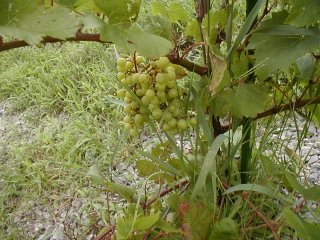A blog about a small start up vineyard near Green Bay, Wisconsin, in a tiny town called Sampson
Friday, December 29, 2006
It was a very good year
Last post of the year and it has been a very good year! (Not just in the vineyard, but the vineyard is the subject of this post.) I had very little winter kill this past year. I got most of my insect and fungus problems under control. And I sold my first small crop of grapes.
I'm certainly finding out it is more work than I had anticipated.
I look forward to 2007 ... my hopes and goals for 2007.
- Plant another 100-200 vines La Crescent, Frontenac or Marquette?
- Be preemptive in eliminating grape flea beetle larvae.
- Increase harvest of Foch from about 260 lbs to over 1000 lbs
- get my first harvest of Saint Pepin
- get my first harvest of Landot noir
- get my first harvest of LaCrosse.
- Sell my grapes to a commercial winery
- Finish high tunnel and begin training vines
- Build or acquire a building for storing vineyard equipment
- Set up frost loss prevention system in the high tunnel
We have been having a very mild December after a chilly start in November .... I hope the weather is kind. Not too many updates until spring except for the occasional weather report.
Friday, October 13, 2006
First frost/freeze of Autumn 2006
Things seemed to harden off several days ago, so I think the vineyard has entered the winter in a healthy state.
Blog entries will probably slow a bit .... I may enter a few about the high tunnel, but Things will start going agian when we hit our winter cold spells, and into the spring.
Monday, October 09, 2006
Little bit of color

I don't know why, but the vines definitely are showing more color this year. I noticed it in many of the wild grapes down here in Madison, and I can definitely tell there is more color in the Vineyard in Sampson.
Still no frost, except for the bottom corner. I expect to get hit within the next few days though. The whole state should get below freezing in the next few days. I pulled the irrigation pump out this weekend, and emptied the hose lines, so I'm ready. Looks like the vines have hardened off well. A good preparation for the upcoming winter, so I think they are ready too.
Saturday, September 23, 2006
Potassium does a vine some good.

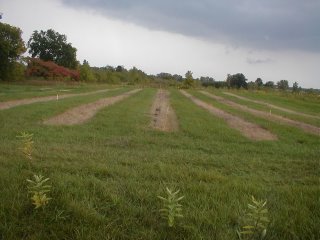 (next years planting location)
(next years planting location)Things still look fairly decent. The major problem appears to be some disease on the lacrosse. There are some mild powdery mildew infections throughout the vineyard, but nothing too major.
We did get nipped by frost in the lower South East corner. Maybe 6 vines got hit, but they are going to be retrained next year anyway.
Wednesday, September 13, 2006
2006 harvest is complete
Only foch was ready to pick this year. There were a few handfulls of lacrosse, saint pepin, and landot noir, but not enough to make any wine. Nine of my nieces and nephews helped, along with several of my brothers and sisters. Many hands made fast work .... we picked all of the grapes in about 1 hour! It was only 260 lbs, still, we made very good time. (note the size of my harvest increased 20 fold over last year's "tolken" harvest.)
That evening I measured my sugar, and acid ...
Brix 19.6
PH 3.16
TA 11.6 g/L
Better numbers than I had thought. But not great.
Next year I expect to have a harvest 4 to 6 times the size of this year's.
Friday, September 08, 2006
Pre harvest readings
(note this was posted the following week.)
Sunday, September 03, 2006
Foch Not ripe yet
I will take measurements on Friday, and decide at that point if I will harvest on Sunday.
Friday, August 25, 2006
Rain, Rain go away
I got an email earlier today from the Mitchel vineyard. They are planning to start picking foch this Tuesday. Not sure if the recent rains will affect them or not. .... It has been a bit drier down there than my back yard.
Monday, August 21, 2006
Ripening progress
 I checked the brix this Sunday the Foch ranged from 15.6 to 17.2. The average was 16.1. There are several green berries on each bunch. I would estimate that about 85% of the berries have completely changed. I also checked the TA and p.h. The TA was off scale (greater than 1.4) and the ph was running 2.6 - 2.8. So there is a lot of ripening to go.
I checked the brix this Sunday the Foch ranged from 15.6 to 17.2. The average was 16.1. There are several green berries on each bunch. I would estimate that about 85% of the berries have completely changed. I also checked the TA and p.h. The TA was off scale (greater than 1.4) and the ph was running 2.6 - 2.8. So there is a lot of ripening to go.We got about an inch of rain over the last week, so that may slow down the ripening a bit. If we get a dry warm stretch, they may be ready to harvest Labor Day weekend, but I am going to try to wait until the following weekend.
Wednesday, August 16, 2006
Overnight Verasion?
They were 90% - 95% green on Saturday! (see the previous post) Maybe I'll be harvesting sooner than I thought. I'll measure the brix this weekend and see where things are at. I had thought picking would happen the weekend after Labor Day. Maybe I'll be picking Labor day weekend now?
Sunday, August 13, 2006
The nets are up, verasion just starting, and some brix numbers
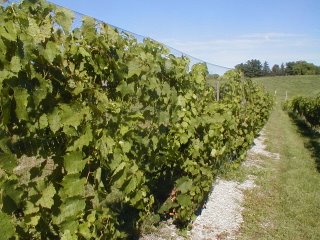
I and two of my nephews put about 350 ft of nets over the foch this weekend. We only put them over the foch on the west end of the vineyard where the vines are older and are bearing this year. I'll need about another 1500 feet of net for next year.... at $0.50 a foot not a cheap investment!
It was fairly easy to put up, but it will be a pain to take down.
Foch 8.8 brix (verasion is just starting)
Landot Noir 4.3 Brix (verasion has not started)
Lacrosse 4.2 brix
Saint Pepin 10 brix
Here is a picture of what I saw with the foch. A few berries have changed, but most are still green. I hope to pick when they reach about 21 brix ... hopefully the TA will .8 or lower.

I also started preparing for next year's planting ... Right now I am planning on planting 200 vines. Hopefully I can get the new Marquette varietal. I mowed and measured out the plot on the East side of the field. I plan on hitting it with some herbicide next weekend, and then till it before the winter.
The experimental pit vineyard is having its problems. Until I get the high tunnel up, it will continue to be decimated by deer. I've tried all of the deterrents I can, but the vinifera must be irresistible. They one again did a number on the vines. The damage is severe enough, that they have destroyed any possibility for a crop next year. I will bury the vines for the winter in early November, and hope for the best next year. If everything goes well, I will have a small harvest from them in 2008.
Sunday, August 06, 2006
Verasion hasn't started yet
Verasion hasn't started yet, but some of the foch grapes seem to have an inner blue glow. I don't remember what preceeded verasion last year, but I think they should be changing in the next week or two.
I have a few grapes hanging on some of the other varietals ... here is some Landot Noir.
I don't have any grapes hanging on the Saint pepin Vines, but should next year.
I also had some help this weekend. Five of my nephews, and one of my neices helped put down some stone mulch around the La Crescent vines planted this year. Here is a couple pictures as proof to their parents, that they actually worked ... or at least that they could pose for pictures so that they look like they are working. :)
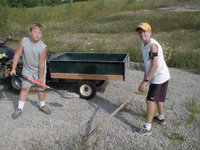
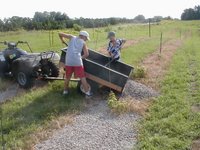
Also ... we have been getting lots of rain lately ... another couple of inches in the last week. Things are very green for early August.
Thursday, August 03, 2006
Bird nets
Audio deterrents
-----------------------
Pros:
-easy to put up
-lasts many years
-moderate cost
-other growers in Wisconsin claim successful use
-may attract other predators, which may aid in keeping birds out
-unobtrusive visually
Cons:
-Needs AC, or car battery, if battery needs to be changed frequently or recharged
-birds get use to it
-questions about effectiveness
-may bother neighbors
Visual deterrents
-----------------------
Pros:
-fairly inexpensive and durable
-often easy to erect
-no noise to annoy neighbors
Cons:
-looks goofy with junk all over the place
-unproven or not affective
Physical barriers (nets)
--------------------------
Pros:
-Very affective
-One time cost
Cons:
-difficult to put up
-difficult to take down
-can be expensive for large vineyards
Since the audio and visual deterrents are not known to be affective, and I only have a few hundred pounds of grapes to protect this year, I decided to get some bird nets. I don't have a lot of vines to cover this year, so I got 4 nets that are 14' by 100'. These should comfortably cover the vines with the most production.
Sunday, July 30, 2006
July 28 - July 29 Things look good.
Over the last 4 growing seasons, it seemed like I would find more problems than success at the vineyard. This year has been MUCH better. I still finds lots of things to work on, but at least things look pretty good every time I get out there.
We got lots of rain over the last couple of weeks. Things look really good. Disease pressure is still quite low. Some signs of powdery mildew, but not too much. Nothing like last year. We have had some very hot weather recently. Two weekends ago, we were in the mid and upper 90's this weekend we were in the upper 80's to mid 90s and will be near 100 F the next couple of days.
No signs of verasion (when the grapes turn to their final color) starting. Last year it happen about the second week of August. Over all things look good. It appears as though I have had 100% success with the fresh LaCrescent plantings. Most seem to be doing well, even the ones that were hit hard by the rose chafers earlier this June. I sprayed RoundUp around them to kill the weeds and grasses. I used a 2 ft high and 2ft in radius homemade cardboard tube to protect the vines as I sprayed. I also sprayed around the Seedless concord which are also are not producing this year.
On Saturday, I sprayed the entire vineyard with Kaligreen. This will be the last spraying I do before harvest which I expect to be around Labor Day this year. I used a rather light spray schedule this year (but more that nothing like the previous years.) It appears to have been very beneficial.
The experimental vinifera vineyard is still battling the deer. It looks like the deer are visiting fairly regularly. Decided to try a trick I read about on one of the grape growing groups. Using high pound test fishing line. I strung 40# test around the plot... I am not hopeful, but until I get the high tunnel up in the next few weeks, it is all I have. Since this is just temporary until I get the high tunnel up, I didn't want to invest in another solar fencer. Speaking of solar fencer, I noticed some odd burning and blackening of some of the grape vine leaves in the park vineyard on the bottom row. It didn't take me long to realize that the burns were from the fencer! The shock from it is very light ... Kind of like a static shock, so I was surprised that it could damage the foliage. Anyway I moved the fence back a few feet from the vines to keep the foliage from getting anymore damage.
Sunday, July 16, 2006
We have grapes!

It has been a while since I have been to the vineyard. I was out of the country for over a week, so this weekend was the first time in 3 weeks that have I been to the vineyard.
In general I had good news. No significant signs of insect pressure and no signs of disease. We had good rains a couple of weeks ago that gave everything a good boost.
I spent most of the weekend weeding, mowing and spraying.
After 3 weeks everything needed a good mowing. I then had to weed the new LaCrescent vines. I also removed the floating row covers that about 10 of the LaCrescent had on them. I don't know how much good the row covers did. The vines without the covering seemed to rebound nicely from the rose chafer damage, with no new signs of damage. The vines under the row covers seemed a bit stunted, and seemed to get a bit of a heat shock when it was removed. I think I may go back to the vine tubes next year for new plantings. However, I think I will get the snap together kind, and only use them the first year.
The concord did look terribly perky. Only a few vines are growing well. No panic from me, since they were really just planted for table grapes and I am more interested in wine grapes.
The La Crosse still look kind of poor. A few are doing well, but they just haven't recovered from all of their traumas over the last few years. This may be why there were so few grapes on the Saint Pepin. They need to be pollinated from another grape variety, and the LaCrosse they were planted next to did not have many flowers.
The Landot Noir, and Saint Pepin are both growing well. If the Landot Survive the winter, I may have a small crop on them next year.

The foch in general look better than they ever have.
 The four year old vines will even produce a nice small harvest. I estimate about 120 lbs of grapes ... maybe a little more. Not a lot, but it's a start.
The four year old vines will even produce a nice small harvest. I estimate about 120 lbs of grapes ... maybe a little more. Not a lot, but it's a start.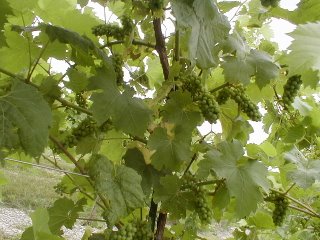
I also sprayed a fixed copper spray to control downy mildew, blackrot and powdery mildew.
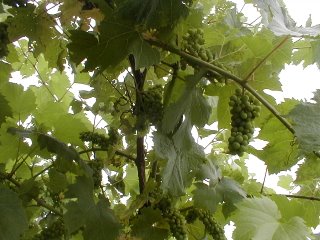 The spray I used was Kocide 2000 (in which copper hydroxide is the active ingredient) ... not Omri approved, but still considered organic I think. ( not that I am seeking organic consideration.) I used about 1/2 cup of Kocide in 25 gallons of water. This is equivalent to 1 lb per 100 gallons. Which is on the low end of the suggested application rates. The temperature was in the upper 80s when I sprayed with a light breeze out of the South West. (I sprayed at about 11:00 am on Sunday) The leaves seem to dry very fast. I did not spray the top LaCrosse row since it was next to the Concord which is copper sensitive. 25 gallons total covered the rest of the vines. When the vines are mature, I estimate I will need about 50 gallons total. I also used about 2-3 ounces of spreader sticker.
The spray I used was Kocide 2000 (in which copper hydroxide is the active ingredient) ... not Omri approved, but still considered organic I think. ( not that I am seeking organic consideration.) I used about 1/2 cup of Kocide in 25 gallons of water. This is equivalent to 1 lb per 100 gallons. Which is on the low end of the suggested application rates. The temperature was in the upper 80s when I sprayed with a light breeze out of the South West. (I sprayed at about 11:00 am on Sunday) The leaves seem to dry very fast. I did not spray the top LaCrosse row since it was next to the Concord which is copper sensitive. 25 gallons total covered the rest of the vines. When the vines are mature, I estimate I will need about 50 gallons total. I also used about 2-3 ounces of spreader sticker.In general disease pressure was low. I'm not sure if this was due to the weather, the dormant lime sulfur spray, or the kaligreen spray in June. What ever it was, the vines sure do look healthy.
The one major bad thing I saw was the deer eating the vinifera again. I hope they'll recover, but it has been a struggle with them. I didn't spend too much time on them this weekend. I hope to spend more time the next time I am up there in a couple of weeks.
Tuesday, June 20, 2006
Status mid June ... some herbicide damage
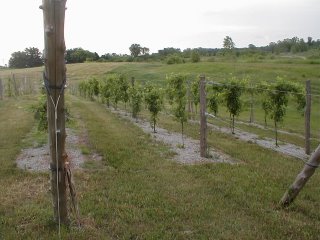 A good week!
A good week!Things looked pretty good the weekend of June 17-18. It was hot and windy this weekend. On Saturday, it hit 91F. Unfortunately, it has been a couple of weeks since the vineyard has seen any substantial rain. We could really use some right now.
The spraying last weekend seems to have been effective. I saw only a handfuls of rose chafers on the vines. I saw almost no signs of the grape flea beetles nor their larvae. The rose chafers were devouring a nearby rose bush and every milk weed in the area.

Speaking of insect damage. I did see something very interesting. In the vinifera, I purposely left any milk weeds I saw last weekend. This weekend the milk weeds were devoured by some type of insects. Completely skeletonized/defoliated. But I have never seen a bug on any of the vinifera or any damage from insects. What's protecting these? The root stock? The varietals?
I gave the vinifera a good weeding/tiling in preparation for the high tunnel. The fence seems to have discouraged the deer over the last week. At least I didn't see any fresh deer damage.
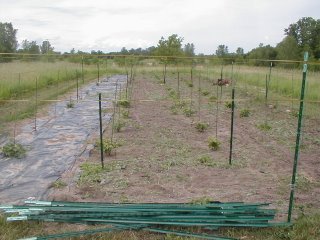
Vines at the park have entered full bloom. A little later than I would have expected since everything had been early up until now, but the cool May and cool shots during June slowed things down a bit.

Herbicide damage?
On Saturday, the vines at the park looked fine, but come Sunday, they had curled bubbly leaves. Looks like maybe herbicide damage? Possibly 2-4d drift? I have read that 2-4D volitilizes in hot weather. Since we haven't had a rain in so long, the herbicide may actually be from several days ago? Just guessing.

Monday, June 12, 2006
Give 'em a fighting chance

The vines are getting hit from the weather, bugs, and more bugs. Well, I decided it's time I give the vines a fighting chance.
The Rose Chafers are back, and back in force. This is the forth year in a row they hit my vines. Last year they showed up on about June 15, this year it was maybe June 10 or a day or two earlier. My notes only note them showing up in June the previous years, and were not detailed enough to know the exact date. Interestingly, the last two years appearances coincided within a day or so of the cutting of the hay field that the vineyard borders. Related? Possibly.
Here they are attacking the LaCrescent vines


 The vines that hadn't been attacked yet were covered with floating row covers. Unfortunately, the row covers really could only be used on the newly planted vines. And the jury is still out on whether they will even work.
The vines that hadn't been attacked yet were covered with floating row covers. Unfortunately, the row covers really could only be used on the newly planted vines. And the jury is still out on whether they will even work. Benjamin Franklin was quoted as saying that the definition of insanity is to do the exact same thing over and over and expect a different outcome. I haven't really sprayed or done anything significant to eradicate them. Well this year was different. I really didn't want to lose another year on the Concords, and lose a year on the LaCrescent. So after surveying the extent of the infestation ... significant, and since bloom hadn't really started, I decided to spray Sevin. I thought it was either use it or lose some vines. The LaCrosse were hit every year by them, and they are in their forth year and will still not bear a crop! The Sevin looks like they did a number on the Rose Chafers... at least the ones that were part of the current infestation. Check out the picture....
Benjamin Franklin was quoted as saying that the definition of insanity is to do the exact same thing over and over and expect a different outcome. I haven't really sprayed or done anything significant to eradicate them. Well this year was different. I really didn't want to lose another year on the Concords, and lose a year on the LaCrescent. So after surveying the extent of the infestation ... significant, and since bloom hadn't really started, I decided to spray Sevin. I thought it was either use it or lose some vines. The LaCrosse were hit every year by them, and they are in their forth year and will still not bear a crop! The Sevin looks like they did a number on the Rose Chafers... at least the ones that were part of the current infestation. Check out the picture....
I am also seeing a lot of damage from the grape flea beetle and its larvae. Several of the laCrosse got hit the hardest, and it looks like no or very little crop off them again this year. The LaCrosse definitely have had it the hardest. It's hard to believe I haven't lost one of those vines completely yet.


You can see the grape flea beetle larvae on the left ( a bit blurry) You can also see the damage to the canopy of the foch on the right.
The LaCrosse showed the most damage. I read that the Larvae damage from the grape flea beetle was typically "minor" ... ha! minor?... look at the picture!
The Sevin should also knock them back too. I'll evaluate status next weekend, but the next spray of Sevin may have to wait until after bloom, which I expect to start in force in the next week or so.
 Not all is lost . Some of the foch was looking quite good. See below
Not all is lost . Some of the foch was looking quite good. See below
Saturday, June 10, 2006
Rose chafers return and so do the deer
I also sprayed kaligreen on the vines this evening. This is Potasium bicarbonate. Used primarily to kill powdery mildew. Also organic.
The deer struck the pit vineyard again. Did quite a bit of feasting. Kellan and Brent helped me put up a 4 strand 6 foot high fence. Hopefully it will slow them down. They also were nibbling on the vines at the park; especially the bottom row.
Although their damage was much more severe at the park.
In addition to mowing and spraying, I spent a lot of time pruning suckers from the vine bases, and retraining some of the vines with bad trunks etc. I'll try to take some pictures tomorrow and post them.
Wednesday, May 31, 2006
Some hot weather and more rain & vinifera survival rates
While the saint pepin did not get hit too hard by the frost in early May, it did get nailed by the
Nearly all of the freshly planted LaCrescent have already got leaves, maybe 2 or 3 of the 48 don't have leaves yet. In the past, some plantings didn't get leaves until late June, so I may still have 100% survival yet. I sprayed Round up between the vines to suppress weeds until I can get stone down. I still haven't planted the extra vines sent. I may plant them on a gravelly hill side in the back 40. I noticed that they are sprouting pretty intensely now.
I haven't done my first fungicide spraying yet. I plan to do it the weekend of June 10. Probably a little late, but you do what you can. I plan on spraying the kaligreen this time, and fixed copper, and kaligreen the weekend of the 24th. I may spray some sevin also especially on the concord and LaCrescent vines which are more susceptible to the rose chafer damage. The rose chafer isn't due until about the June 15, but since everything is about 1 -2 weeks early, they may be there by the end of the first week in June.
I also scouted the vinifera vineyard.... I lost several vines to rodents. Of the 75 vines I have 44 left. Most of the vines lost were the chardonnay.
Here are the vine types with there row positions and survival from west to east
S F M F C
8 9 13 10 4
S=Cabernet Sauvignon
F=Cabernet Franc
M=Merlot
C=Chardonnay
Finally, I pruned off many of the suckers from the bases of the foch. Several vines in the lower south east corner, are going to have to be retrained from the bases. They were pruned back or sometimes the tops were lost either due to frost or freeze problems.
We did get bit by the frost on Sunday night and Monday night May 21-22. But mostly just the lower buds and lower shoots, especially in the lower south east corner, but not nearly as damaging as the May 6 freeze. (many of the dead shoots and buds from that freeze are still visible.)
Tuesday, May 23, 2006
Missed me by that much
very light, no major damage that they could see. I'll know for sure this weekend when I get up there.
We are expecting much warmer temperatures over the next several days. If things have progress well enough by this weekend, I plan on spraying.
Sunday, May 21, 2006
Another frost ? Grape flea beetles.
Most of the secondary buds haven't broken yet, but some primaries on the st pepin have just begun to break. Overall it would not be good timing.
I spent the weekend mowing and trimming around the vines. Vine winter survival looks excellent. Surprisingly, I haven't lost a single La Crosse vine from last year .... I'll have to recheck my notes, but I think I had some marked as completely dead, so imagine my surprise to see some life on every single vine! Also it looks like I only lost one seedless Concord; I am very surprised, especially after the severe damage from the Rose Chafers last year.
My scouting also revealed more significant grape flea beetle damage. I'll have to read up on how to best control them. Sure are a lot of dead primaries from the frost a couple of weeks ago. Very sad to think how healthy things were looking prior to that frost, and now all the damage. Oh well.
I got the irrigation equipment installed. I still need to work on the drip lines, but the pump and hose from the water to vines is all set up. Only found one leak. It may have been caused during storage, I may try to leave it in place next year. I'll just have to make sure the water is purged first.
The vinifera look a bit better than I thought. still lost several due to rodents, but enough survived to make it worth it. I will have to replant a dozen or so.
Monday, May 15, 2006
Satellite image of last week's freeze

I pulled the data from the GOES-12 weather satellite for the freeze last Friday night. I enhanced it to show where the temperature was above and below freezing. I then made an animated GIF with cross hairs on a few select vineyard locations that I knew the exact latitude and longitude. It is somewhat hard to tell what is what, but the animation helps. If you are planning a vineyard, you may even be able to spot good locations that would be less likely to experience a late spring frost. http://jerroldr.googlepages.com/home
Saturday, May 13, 2006
LaCrescent vines arrived and planted
I'll probably put the remaining LaCrescent into a trench until I can plant them in a couple of weeks. I still have to decide exactly where I will put the vines.
Took a look at the frosted buds on the vines. They look pretty dead. I noticed that most of the Saint Pepin had not broken bud, so I may get some reasonable production from those. I also noticed some damage from grape flea beetles. Remains to be seen how much I'll have to deal with them.
Wednesday, May 10, 2006
The vines arrive ... well not exactly
I had all of my holes ready before I discovered the mistake, so I planted the ten LaCrescent vines that were sent. I mixed in about a tablespoon of muriate of potash with each vine.
I heeled the 50 LaCrosse vines on the Northwest corner of hill under some box elder trees. I then covered them with a tarp. I'm not sure where I am going to plant them. I am out of space near the park. I may put them on the east end of the same field.
I also got 6 replacement cab sauvignon vines that died immediately after planting last year. I planted them in the same location where the other vines died.
Tuesday, May 09, 2006
The frost damage
Even if those aren't a second primary, and is the secondary, all is not lost. Unless we have another freeze :( The extended forecast does not show much of a warming over the next week or so, maybe even another freeze next week. I hope not.
While yesterday was quite productive, with temperatures in the 60s and 70s. Today was not. It rained steadily almost all day. We got a little less than a half inch at the vineyard. I was able to amend the soil where I will be planting the LaCrescent later this week. I have about 48 LaCrescent vines to plant. The vines will be going into two 200 ft rows.
 I added 5 lbs of muriate of potash to each row, and about 7 lbs of aluminum sulfate to each row. The potash was to correct the low potassium, and the aluminum sulfate to lower the ph ... the soil is quite alkaline in our area.
I added 5 lbs of muriate of potash to each row, and about 7 lbs of aluminum sulfate to each row. The potash was to correct the low potassium, and the aluminum sulfate to lower the ph ... the soil is quite alkaline in our area. Tomorrow, I will try to get the holes for the vines ready. Hopefully the vines will show up tomorrow, and I can get them in the ground. But they may have to wait until Thursday or Friday ... when the temperatures are in the 50s and it's raining heavily.
Sunday, May 07, 2006
Frost in the vineyard
Bud break began earlier in the week; I estimate about 75% of the buds had broken by Friday night.
 The freeze damage was scattered through out the vineyard, and I am not sure how severe the damage is yet. Some of the shoots that were already an inch or more long showed some severe damage. Some of the buds that had broke more recently, appeared as though only the outer leaves were damaged. I tried to take some close up pictures, but the digital camera with auto focus didn't work too well ... here is my best attempt at a picture of the damage on one of the vines.
The freeze damage was scattered through out the vineyard, and I am not sure how severe the damage is yet. Some of the shoots that were already an inch or more long showed some severe damage. Some of the buds that had broke more recently, appeared as though only the outer leaves were damaged. I tried to take some close up pictures, but the digital camera with auto focus didn't work too well ... here is my best attempt at a picture of the damage on one of the vines.The damaged caused the outer bud leaves to look black or brownish. I hope to assess the severity of the damage later in the week.
After a warm start to the upcoming week, it is suppose to turn colder and wetter starting Wednesday. The LaCresent vines that I am planting this year, ship on Monday, and I should receive them by Wednesday or Thursday. I plan to plant them the day after they arrive.
I have the week off to do vineyard work this week. On tap for tomorrow is trellis work, application of some herbicide, and other odds and ends.
Wednesday, April 26, 2006
Whew ... Bullet dodged, but not out of the woods yet.
Tuesday, April 25, 2006
Frost possible tonight
My foch and cab franc in the backyard broke bud late last week, and may be susceptible tonight, but I'll take my chances. Talked to Norm Stilson from the Prairie Home Vintners club tonight, and his vines are swollen but have not broken, his vines are on a west facing slope. One of the disadvantages of my vines being on a south facing slope, is the risk of frost injury in the spring.
Friday, April 21, 2006
Bud break in Madison
I don't know if the buds broke up in Sampson yet, so I'm not sure if I should be concerned.
Sunday, April 16, 2006
Buds swelling in Sampson

My weekends are full the next 3 weeks, so I took the opportunity to do a little work on the Saturday before Easter Sunday. The foch buds are really swelling. I hope they don't break soon, because there still is a lot of time that a frost is possible. I was encouraged by how little winter kill I experienced.
It's been drier up in Sampson than down in Madison. We could use a little rain up there.
I took the tarp off the second half of the experimental vinifera. These looked better than the first half I uncovered. When I prunned them they were nice and green inside.

Unfortunately, some of the vines look like they were a mid winter snack. I am concerned about the vines that were heavily gnawed by rodents. At least one chardonnay vine was definitely killed. I suspect several others may have also died. I thought the winter might get them, but it looks like it may have been mice.
Tuesday, April 04, 2006
Purple foot Acid tester
Saturday, April 01, 2006
Spraying Lime sulfur
Thursday, March 30, 2006
Springtime Pruning cont. "What lies beneath?"
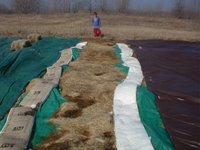 the beginning of May. But I began to worry that the heat may cook them. To hedge my bets, I decided to remove the tarps from half of them. I removed the tarp from the North half.
the beginning of May. But I began to worry that the heat may cook them. To hedge my bets, I decided to remove the tarps from half of them. I removed the tarp from the North half.I have two layers of tarp, with hay and fiberglass insulation sandwiched between them. It was my hope that these would be a nice dry layer to keep the vines warm. Unfortunately, I saw more rodent holes in the top tarp. It slowly became apparent that my tarp/hay/insulation sandwich was an ideal rodent overwintering home. The holes in the top tarp also let rain and melted snow in between the tarps. This caused about 2/3 of the hay and insulation to become wet. Not nearly as good of an insulator.
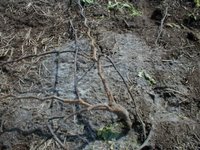 After scraping off the wet hay and insulation, we removed the lower tarp layer. Things did not look too bad. The rodents did chew on the vines, but not to the extent that I feared. In fact most of the chewing looked to be very superficial near the base ... almost like they only ate the wax covering the graft unions.
After scraping off the wet hay and insulation, we removed the lower tarp layer. Things did not look too bad. The rodents did chew on the vines, but not to the extent that I feared. In fact most of the chewing looked to be very superficial near the base ... almost like they only ate the wax covering the graft unions. (merlot pruning, looking pretty green!)
(merlot pruning, looking pretty green!)I put up some light wire around the part of the vineyard that I removed the tarps. Hopefully enough of a deterrent to keep the deer from chewing on the leafless vines until I get up to install the high tunnel.
Wednesday, March 29, 2006
Springtime Pruning
 It's beginning to feel like spring may have finally arrived. I took off all of last week to do vineyard work. Number one on my agenda was pruning.
It's beginning to feel like spring may have finally arrived. I took off all of last week to do vineyard work. Number one on my agenda was pruning.It took me about 2 days (March 27-28) to prune the park vineyard. Overall things looked better than I expected. I saw little winter kill on the Foch, LaCrosse and St Pepin. Some of the ends that did not harden off were brown, but for the most part things looked good. I've been fooled before, thinking that things were alive when pruning, and then finding that they didn't make it. But I'm more optimistic this year. I did see more winter damage in the Landot noir, but that is the least hardy of my vines and is somewhat expected.
Here is a pruned foch vine: ... still kind of a baby, but should have a small crop this year!

I was also finally able to check out the experimental vinifera vineyard. The tarps on one end were pulled up slightly, but overall things looked pretty good at this point.
I did see a couple of holes chewed into the tarp which concerned me. I hoped at this point not to find too many rodents living under the tarps.

On Wednesday, March 29. I, my brother Jon, and my nephew cleared the "scrub" boxelders on the hillside overlooking my vineyard. Getting rid of these not only improve the looks around the vineyard, but also allows better air flow around the vineyard, and hopefully will make the deer feel less secure chewing on the vines.
Tuesday, February 21, 2006
High tunnel heat math ... is it worth it?
(Surface AREA in SQFT )*(Temperature difference in F)*1.2 =BTUs of heat needed
The hoop house I intend to use will have an area of about (96*16*PI)+(PI*16*16)=6,534.5 SQFT
Let's try an example:
From the last weekend ... I spent 19 consecutive hours below 3 F The average Temperature over this period was about -8 F or an average temperature difference during this time of about 11 F.
So ..... (6,534.5*11*1.2)=86,255 BTU/hour needed to remain at 3F or higher.
I have two 60,000 BTU forced air kerosene heaters. They should be able to supply a total of 120,000 BTUs per hour. They can last about 12 hours of continuous heating.
So based on this ... I should be able to last a little less than 17 hours. These calculations do not take in account any thermal inertial due to heat retained in the ground or any additional insulation ... which I intend to use. I may have to get a couple of backup heaters ... or refuel more often.
Next, I have to build my computerized controllers .... luckily I have quite a bit of experience with this part. The entire computer controlled heating system should cost about $400 to build(including heaters). Fuel should cost about $4/hr. Even in a cold year, cheap insurance to keep the vines alive. This year it would have cost me about $100 bucks in fuel costs (worse case) to allow my 75 vinifera vines to survive the winter.
Extending the costs over 10 years .... assume on average 100 hours of heat per year over 10 years:
high tunnel=$4000 --- one time cost
heat=$4000 ---- ~$400 per year
Other misc =$500 --- sensors, computer controller ... tarps etc.
______
$8500
Assume 20 lbs/vine/year
=20*75*10=15,000
So this system will add $0.56 per pound of grapes. Even if you go best/worst case ... I think you can go plus or minus a .25 per pound i.e. $.31 - $.81/lb . .... note vinifera shipped in from the west coast will cost any where from $0.65 to as much as $1.50 per pound (in small quantities) when shipping is included, so then this begins to look competitive. And hey.... they were grown in Wisconsin! And this does not take into account the reduced risks due to Frosts, Winter kill, reduced pests, and the costs associated with them. This is all theory so far ... we will see how reality plays out ... it may be far more harsh than I anticipate, but many of the numbers and costs I used I hope to beat.
Sunday, February 19, 2006
A bit chilly (-17 F in the shade)

A late winter cold snap hit the vineyard this weekend. Friday night the temperature dropped to -17 F. It's the coldest weather we have had since the vineyard was planted in 2003. Last night we dropped down to -7 F. Luckily we had about 10 inches of fresh snow added to the 8 inches already on the ground. I am concerned that the recent mild weather (i.e. all of January, and the beginning of February) may have hurt the hardiness of some of the vines. I think the Vinifera under the tarps were fine. Thankfully the vineyard didn't get as cold as my backyard here in Madison, where I recorded -21F.
Monday, February 13, 2006
What's Under there??
I noticed a lot of activity around the vinifera under the tarp. I saw a lot of tracks ... I think they were either coyote or fox ....

I also see some digging.... I wonder if the coyote (or fox) could here rodents under the tarp?

If so I hope the little critters living under there aren't feasting on the vines!
Sunday, February 05, 2006
Day 2 at the Wine and Grape Conference
The day started with a real nice breakfast .... fruit, eggs, sausage bacon, crepes ... you name it, much better than the typical continental breakfast spreads. But enough about that ..... Lets get to the wine and grape talks.
The morning started out with a keynote about the Winegrape industry in Iowa. This was followed by parallel sessions dealing with wine or grapes.
Luckily, two folks I knew and were attending the conference, Randy Harrison and Norm Stilson, attended some of the talks that I missed, so I will have to tap them for more info on the talks I did not attend. (Randy is a amateur winemaker and attended some of the winemaking talks. Norm is a grower and also makes wine, so he was splitting his time between the parallel tracks, as was I.)
So here is the quick summary:
Iowa experience (Mike White)
13 Iowa wineries in 1999 ->52+ wineries by Feb 2006
31 acres grapes growing in Iowa in 1999 -> 600+ in 2005
imported a lot of expertise
Evaluating Cold Climate Cultivars (Dr. Paul Domoto)
Late Frosts have huge impacts on many of the cultivars. And organic is a challenge in the Midwest. Site selection has huge impacts.
Wine Faults (Todd Steiner)
Don't skimp on those sulfites!
Lunch (quite the spread again!)
Wine Makers Forum(various)
Sweeter wine sells ... Iowa and Minnesota wines aren't cheap!
Working together as a State Grape and Wine industry (Donniella Winchell)
With good outreach, networking and smart promotion a grape and wine industry can reap huge benifits.
Dinner and a tribute to Bob Wollersheim
A great dinner and a heart tugging tribute to Bob Wollersheim
If I haven't lost you yet ... here are the details. (note this may or may not be the highlights, just my impressions.)
Iowa experience
This was presented by Mike White (a very entertaining guy by the way) from Iowa State University Extension.
What they have done in Iowa since 1999 is impressive. Going from ~30 acres of vines to over 600 now. They had 13 wineries in 1999 and 52+ now. This was no accident. It helped that Iowa invested in the industry .... a wine and grape development council was appointed, the Universities hired researchers, extension specialists, and more.
They were also beneficiaries of some unique native winery laws like Native Wineries being exempt from some wine taxes, liberal licensing to sell Native winery wines at businesses that are not typical wine outlets (like flower shops, gift shops, etc) cheap/liberal licensing to allow wine sales by the glass at festivals and events.
This talk made me wonder why ..... WHY ... isn't Wisconsin doing some of the same things?
Evaluating Cold Climate Cultivars
This was presented by Dr. Paul Domoto. Dr. Domoto is a horticulture professor at the Iowa state University. This talk was somewhat Iowa centric, but in some ways was more relevant to my climate than many of the Minnesota oriented talks.
Dr. Domoto talked about two sites growing the same grapes. One site was significantly more frost prone than the other. Three management systems were also evaluated. They were:
-Conventional
-IPM/Best Practices
-Organic Approved
In many cases the difference in these approaches were by far insignificant when it came to site factors ... such as frosts and cold injury. However, in general the organic suffered as one may expect.
Some general Notes:
All of the cultivars varied significantly. While there was a variation between cultivars, there was a huge variation between the sites. When there were late spring frosts, it had a huge impact. The cultivars with late bud beak had virtually no damage.
Winter low temperatures between the two sites varied by about 8 degrees -11F at one site -19F at the other. Huge difference were seen due to bud damage from the colder temperatures.
Additional sites and cultivars have been planted and additional information will be coming from those.
A lot of info was presented in this talk ... I don't think I even hit all of the highlights.
Wine Faults
This was a talk I really looked forward to. It was presented by Todd Steiner from the University of Ohio. We did not get a handout on this, so I have limited notes.
We evaluated 10 wines, 5 red, and 5 white. One red was a control with no faults and one white was a control with no faults. We first tried the whites:
I was easily able to identify the flaw in both #2 and #3 (since I have had wines that suffered each)
1. White Wine control
2. Oxidized white. Brownish in color sweet nutty sherry aroma and taste .... due to too much oxygen . Too much head space, too much splashing when racking. This is the least offensive to me, since I like sherry. But this is a recognized fault.
3. VA problem i.e. volatile acidity problem i.e. acetic acid i.e. VINEGAR. Distinct vinegar smell. Due to poor sanitation, or insufficient sulfites, too much oxygen or head space.
4. lactic acid spoilage. This one smelled like sauerkraut. May sometimes have a ropey filaments in it, but is less common. Due to insufficient SO2(sulfites). Typically due to a natural malolactic culture.
5. Protein haze. We only got to see this one.
Now the reds.
I recognized 2 out of the 4 flaws. Only once did I have a wine suffer from one (#9).
6. Red control
7. High alcohol and fusel alcohols. I thought this smelled a bit like lighter fluid, rubber (and slightly like rotting flesh!) it had a hot taste. This is often due to certain yeast strains and or high fermentation temperatures.
8. Brett ... I have read about this, but did not know what it smelled like. It smells like a first aid kit or band aids. Brett is caused by a bacteria, so sulfites would help, but it is anaerobic so air is less of a factor. Sometimes found in Bordeaux wines (intentionally?)
9. Film yeast . Wine flowers, ethel acetate. Smelled like fruity nail polish remover. Prevented with adequate sulfites and topping up.
10. Geranium smell due to adding sorbate to a malolactic fermented wine. I have noted this in a couple of wines I've tried ... never my own, since I haven't added sorbate to very many. This example was a commercial wine, and it had an overpowering geranium smell! Simple solution; keep sulfites up so malolactic does not start, or don't add sorbate to a malolactic fermented wine .... be careful with blending .... a malo fermented wine blended with a sorbated wine is just as bad.
Winemaker Round table
I won't go into too much detail here, but this was a fascinating one. We try 10+ different wines with the winemakers of those wines explaining in detail the chemistry and methods for making the wines. Great insights are gained from this. I was shocked at some of the prices that they sell these wines for. I think $12 was the cheapest. Most were between $15 and $20. When we were trying the sweeter wines, one of the wine makers noted that it wasn't his favorite, but by far the sweeter wines were the ones that sell.
Working together as a State Grape and Wine industry
This was the final talk and the keynote. Donniella Winchell gave this presentation .... she is the Executive Director of the Ohio Wine producers association. There was too much information to even touch a little on what was presented in this talk. The bottom line was you really have to get involved and network at every level .... from legislatures to tourism boards to news media. You really need to promote. Great info.
Dinner and tribute to Bob Wollersheim
The conference concluded with a dinner and tribute to Bob Wollersheim. The dinner was served with several bottles of wine from some of the attendee wine makers.
At the end of the dinner Philippe Coquard, who is the son-in-law of Bob Wollersheim and winemaker at the Wollersheim winery, showed a movie that was wonderful picture history of the Wollersheim winery that Bob Wollersheim himself made in 2002. Bob was also posthumously awarded the Elmer Swenson Achievement Award, Philippe and JoAnn Wollersheim accepted the award on Bob's behalf.
Friday, February 03, 2006
Minnesota Grape Growers Association Cold climate Grape and Wine Conference …. And a break in the “heat” wave.
(NOTE if you are looking for Minnesota Grape Grower Association here is the link
http://www.mngrapes.org/ Not sure why google is directing everyone to this page instead of that one? But look around if you like.)
Today is the first day of the MGGA Cold Climate Grape and Wine Conference. As last year, it has already proven to be well worth it.
Okay … the weather on the drive in wasn’t the greatest, but from what I heard from others, it sounded like I beat the worst of it. I left Madison about 6:45 am this morning and arrived in Rochester, MN around 10:00 am the drive was fine up until the last 30 miles, when rain started freezing on my car and road. Luckily traffic was light and I made it to the Kahler Grand Hotel safe and sound. Looks like our 40+ day streak of 30F or higher is over.
This afternoon’s talks were about:
-Grape Diseases
-Grape Pests (primarily of the bug variety)
-Grape Growing Keys to success
-Vineyard Fertilization
-Vineyard Economics
So far all of this year's presentations were presented by “academics.” Last year it was nice to get the mix real life grower experiences along with the academics, but I really enjoyed this years more academic approach.
First a quick summary of each talk, then a little more info:
Grape Diseases:
Black Rot and Downy Mildew 2 top grape diseases in Illinois. Moisture in general bad. Get a handle on them early.
Grape Pests
Fairly easy to deal with it… the longer and more common grapes are grown in the Midwest, the more there will be.
Grape Growing Keys to success
Location, Location, Location …. Oh and use good vineyard practices
Vineyard Fertilization
Preparation, preparation, preparation … i.e. get it right before you plant
Vineyard Economics
So you want to start a vineyard … you must be crazy
The WINE reception
Drink wine, talk, drink some more wine, talk some more, drink more wine
Okay … now a little more detail on what I remember the most from each talk.
Grape Diseases (the longer version)
Presented by Dr. Mohammad Babadoost
This was a great talk. I gained a greater understanding of how to deal with some of the disease issues that I have had in my vineyard. Specifically, I learned that I have spots of Anthracnose scattered throughout my vineyard. This was something that I noticed, but despite my research I hadn’t been able to identify it … seems easy to deal with. Liquid lime sulfur should take care of this … should be sprayed while vines are dormant … I will probably do this in March.
Several literature resources were also provided, and I will probably try to get some of those.
And finally some suggest spray schedules were provided that I may draw upon. Over all very educational. He mentioned that Black Rot and Downey mildew were the two biggest diseases in Illinois, but it has clearly been a different story at my vineyard.
Grape Pests
Dr. Bill Shoemaker
Very interesting, but luckily most or all of the pests that were discussed have not been an issue in my vineyard … that is except for Deer. Rose chafers were not even mentioned …. Am I the only one that these buggers attacked!!!?
He also mentioned that we are still learning about which pests will be issues in the future. As more grapes are planted, and the longer they are in this area, new pests will emerge as problems.
Grape Growing Keys to success
Eli Bergmeier
Another great talk, but not enough time to cover all that he had…. He could have easily gone another hour, and not covered all of his topics.
He mentioned that two of the biggest reasons for Vineyard Failure are Site selection and weeds …. Yes WEEDS ! He showed an example of how a site with poor cold air drainage had a frost 2-3 weeks earlier than another nearby location with good cold air drainage, and 3 late spring frosts versus the location with good drainage, that only had one!
He also touched on the wetness of the location … not much new here for me.
He also talked a bit about planting …. He used an auger similar to me, but I learned that something called glazing can occur. … This is when the sides of the auger hole are wet and compacted, and create a clay pot situation … I don’t think this has been an issue for me, since my soil has a good organic matter content (~2%) …i.e. not too high, and is relatively loamy.
Time was running short, and I wish he would have spent more time on trellising, but I have enough info from the handouts so I can study them.
Vineyard Fertilization:
Dr. Paul Domoto
If I had to choose a favorite section, it wouldn’t be easy, but this would be it. I liked this talk so much, because this was information I was desperate for. I had my petiole and soil and analysis done this year, but I felt like it was not interpreted well enough, and the significance of certain things were not clear to me.
Dr. Domoto broke down the ideal values for the types of cultivars grown in this climate. Bottom line …. My Potasium is way too low, but I knew this. That is why I added the soil amendment this fall. And by PH is too high. 6.0-6.5 is ideal, mine is about 7.0.
Of course I should have made my adjustments prior to planting … which I did with my latest vines, but the little additional info I have now, would have been a big help.
Here are my numbers compared to the ideal
| Petiole Nutrient |
| My Vineyard |
| N | .9 - 1.3 % | 2.82 |
| P | .16 - .29 % | 0.26 |
| K | 1.5-2.5 % | 0.57 |
| Ca | 1.2-1.8 % | 1.39 |
| Mg | .26-.45 % | 0.55 |
| S | >.1 % | 0.21 |
| Zn | 30 - 50 ppm | 17.33 |
| B | 25-50 ppm | 35.00 |
| Mn | 31-150 ppm | 43.33 |
| Fe | 31-50 ppm | 54.67 |
| Cu | 5 - 15 ppm | 10.33 |
Soil Sample | | |
| Soil ph | 6 - 6.5 | 7.23 |
| OM | 2 - 3 % | 2.17 |
Vineyard Economics
Dr. Bill Shoemaker
The last talk also by Dr. Shoemaker, was kind of a reality check …. Basically… be prepared to not make any money for a while. You really need to plan and treat this vineyard like a business …. Maybe obvious, but you really need a business plan. I wrote one up a while ago, but I realize now, that I need to add much more detail. I asked the guy next to me (Kent), who hasn’t started his vineyard yet, but is in the planning stages … “ So did he scare you?” he said “nope” …. I thought …. I already made most of the mistakes he mentioned, and so hey … bring it on!.
The Reception
The talks were great, but the reception Friday evening was another thing to look forward to. This gave everyone a great opportunity to mingle, learn, and sample many different wines.
I talked a bit with Mark Hart from Bayfield, WI … he’s a grape breeder on the shore of lake Superior. I asked him a bunch of questions about grape hardiness as it relates to warm and cold spells. He said the biggest risk are big fluctuations … more so than the extremes … well not too extreme. He said that when we go from warm (50+) to very cold –10F over a short period of time, that is more damaging than a slow progression from one to the other. Good to know.
Then there was the wine …. I would have to say that some of the amatures matched or easily surpassed some of the commercial wineries. Tasted some very interesting blush style wines, some very good whites, and a lot of good reds … probably tried 20 or 30 total …. Definitely had to dump and pace myself. Tasted a very good Frontenac, Cabernet Sauvignon, Zinfindale blend. Couple of good Frontenac … some not as good Foch. And a couple of amature wines that were better than some of the big guys.
More tomorrow.
Thursday, January 19, 2006
Now this is my kind of Winter!
We've gone 30 days in a row with temperatures near 30 F or higher. We also haven't had too many really warm days to significantly hurt the cold hardiness of the vines. The next week is forecasted to be in the 30s and 40s. I probably didn't even need to cover the vinifera this year.
I'm very optomistic about a good harvest this year.
The Cold Climate grape and wine conference is coming up Feb 3 - Feb 4. It's in Rochester, MN again this year. I learned a ton last year, and I am looking very forward to it again. I'll probably report next from the conference.



